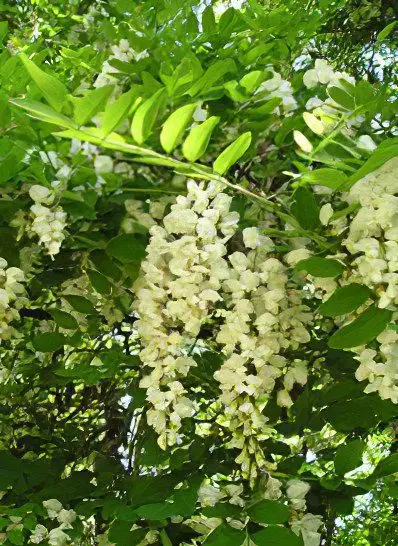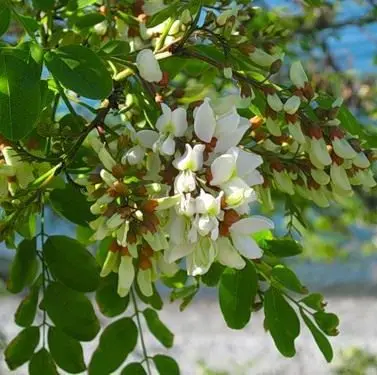Recipes for the use of the medicinal properties of white acacia
Botanical description of white acacia

White acacia is a large tree, the height of which reaches 15–20 meters. This tree belongs to the legume family, and it is very often used in the folk treatment of various diseases. White acacia has a beautiful and spreading crown, longitudinal cracks are visible on the tree trunk. The trunk of the white acacia is gray-black or gray-brown in color. Shoots and young branches of acacia are green and smooth. The leaves of the acacia are egg-shaped and arranged oppositely on petioles of 7-21 pieces. The outer side of the leaves is smooth and green, and the inner side is velvety gray-green. Acacia white flowers are white, smell pleasant and are collected in brushes that droop.
White acacia blooms from the end of May, and it ripens in June. The fruit of the white acacia is a dark brown flat pod with 4–6 bean-shaped seeds. White acacia was first seen in North America, and after it was transported to the south of our country. This tree grows most often in parks, gardens and along roads.
Collection and harvesting of white acacia
Medicinal raw materials are flowers, fruits, leaves and bark of white acacia. Flowers must be harvested at the stage of their flowering, and they are collected in a half-blown form. Drying should be done in a room that is well ventilated and has a temperature of 40-50°C. The bark and foliage should be collected during the growing season.
Medicinal properties and uses of white acacia
In folk medicine, a decoction of white acacia bark is used, this helps people who have exacerbated gastritis or peptic ulcer. Young shoots and leaves are raw materials for the preparation of tincture, which is taken during exacerbation of peptic ulcer and gastritis. Infusion and decoction of white acacia flowers are used for diseases of the kidneys, bladder, and also for rheumatism. The flowers are used by combining them with the leaves of the common bearberry, the flowers of the common tansy, as well as the flowers of blue cornflower and licorice root.
The chemical composition of white acacia
The chemical composition of the white acacia, and especially its fruits, is still not fully understood. Acacia bark and flowers contain the flavonoid robinin. This substance has a hypoazotemic effect – it removes urea from the body. On the basis of Robinin, medicines are made. However, this substance is toxic, which means that self-treatment of any disease with the help of acacia is dangerous, in any case, you need to consult a doctor.
Flowers and leaves contain various flavonoids, fatty oils, glycosides, essential oils, tannins, pectins and sugars, vitamins and minerals, as well as organic acids.
Recipes for the treatment of white acacia

With uterine myoma and inflammatory disease of the female genital area, a decoction prepared from white acacia flowers is taken. To prepare it, take 1 tablespoon of dried flowers and pour in two glasses of water, bring to a boil and leave for another 2 minutes on low heat to boil a little. After that, strain the contents, cool and add water to get as much as it was before boiling. Such a decoction should be taken daily 3-4 times half an hour before meals, 1 tbsp. spoon.
Tincture of white acacia flowers is taken for infertility. To do this, pour 10 grams of flowers (fresh) with 10 grams of alcohol or vodka. We insist all this for 10 days. This tincture should be taken 3 times a day, but not in pure form, but diluted: 20 drops of tincture should be mixed with one tablespoon of water.
With rheumatism, myositis, joint pain and sciatica, rubbing is done. To do this, you need to take 2 glasses of vodka, pour 50 grams of acacia flowers into them, insist for three weeks in a dark room, but do not forget to shake occasionally. When the mixture is infused, strain it – and the rubbing liquid is ready. Rubbing should be done a couple of times daily.
For coughs and colds, or as a fever reducer, a decoction of white acacia leaves is used. You need to take one tablespoon of dried leaves, crushed into powder, add 1 cup of boiling water, put on fire and boil for 5 minutes on low heat. After the broth, you need to cool, strain and take 3 times daily before meals, 1 tablespoon.
Acute and chronic cystitis can be cured by collecting white acacia flowers, wheatgrass root, calendula flowers. 50 grams of this collection should be poured with 300 milliliters of water, brought to a boil, boiled for 8 minutes. Next, the broth must be removed from the heat and insisted for 60 minutes, then strain and add more boiling water to the initial volume. You need to drink such a decoction daily 3 times before meals, 50 ml each.
Contraindications to the use of white acacia
Acacia white should be taken in moderate doses, because a large dose is poisonous. Acacia bark is the most dangerous, as it contains robin toxalbumin, a toxic protein substance that can irritate mucous membranes.
Acacia should not be taken by people with low stomach acid. When harvesting wood, the following symptoms of malaise may occur: nausea, vomiting, headache, drowsiness.
Horses are very sensitive to alkaloids. When animals are poisoned by acacia, they are tormented by pain in the abdomen. Horses are agitated, their limbs tremble, their hearts are not working as well as they used to. In case of poisoning, the first thing to do is to rinse the stomach and give the horse absorbents.









